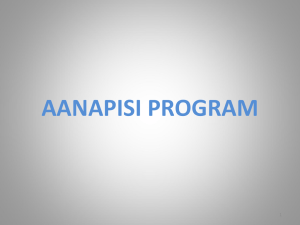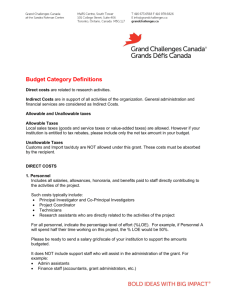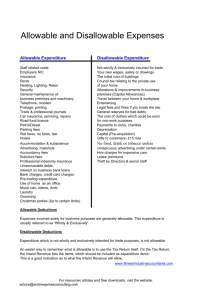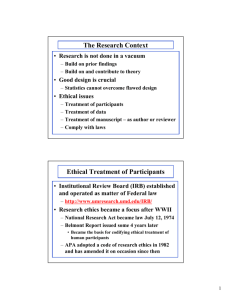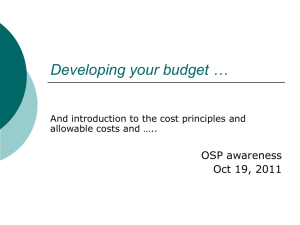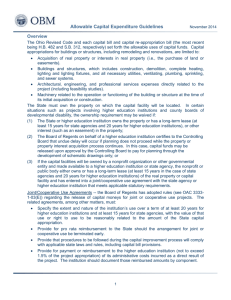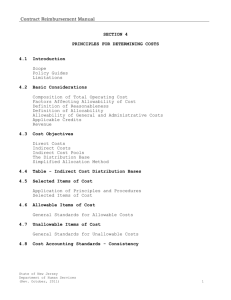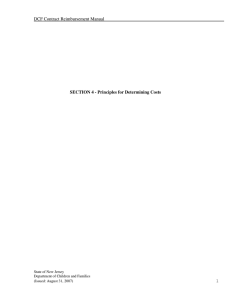Cost Analysis and Appreciable Contribution Work Sheets
advertisement
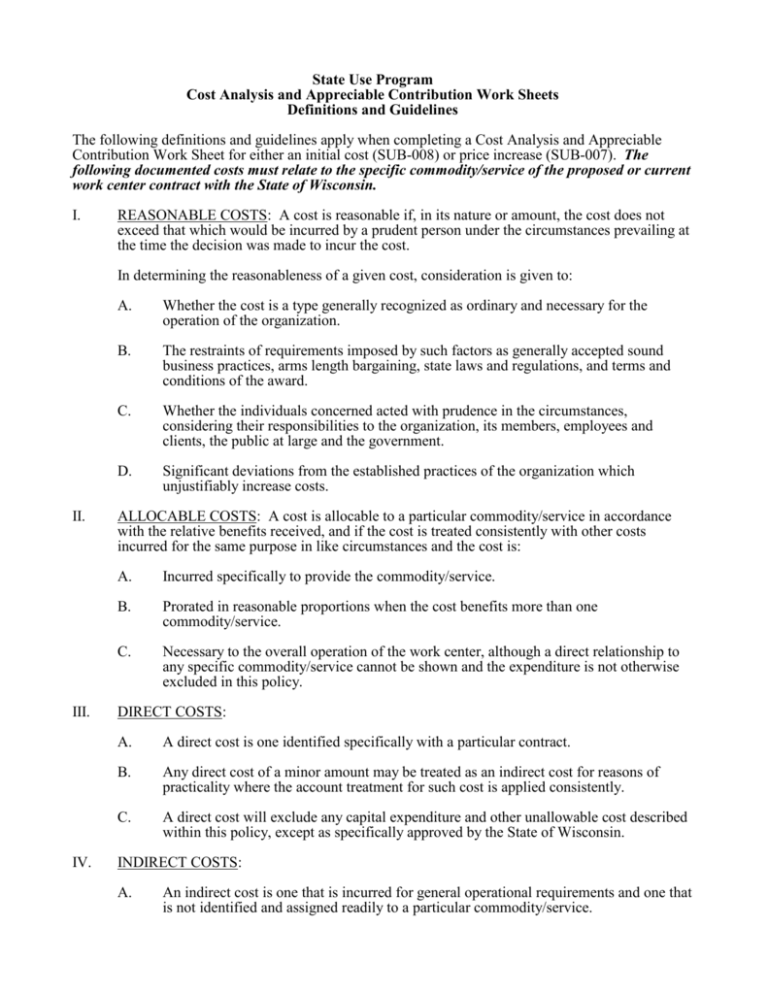
State Use Program Cost Analysis and Appreciable Contribution Work Sheets Definitions and Guidelines The following definitions and guidelines apply when completing a Cost Analysis and Appreciable Contribution Work Sheet for either an initial cost (SUB-008) or price increase (SUB-007). The following documented costs must relate to the specific commodity/service of the proposed or current work center contract with the State of Wisconsin. I. REASONABLE COSTS: A cost is reasonable if, in its nature or amount, the cost does not exceed that which would be incurred by a prudent person under the circumstances prevailing at the time the decision was made to incur the cost. In determining the reasonableness of a given cost, consideration is given to: II. III. IV. A. Whether the cost is a type generally recognized as ordinary and necessary for the operation of the organization. B. The restraints of requirements imposed by such factors as generally accepted sound business practices, arms length bargaining, state laws and regulations, and terms and conditions of the award. C. Whether the individuals concerned acted with prudence in the circumstances, considering their responsibilities to the organization, its members, employees and clients, the public at large and the government. D. Significant deviations from the established practices of the organization which unjustifiably increase costs. ALLOCABLE COSTS: A cost is allocable to a particular commodity/service in accordance with the relative benefits received, and if the cost is treated consistently with other costs incurred for the same purpose in like circumstances and the cost is: A. Incurred specifically to provide the commodity/service. B. Prorated in reasonable proportions when the cost benefits more than one commodity/service. C. Necessary to the overall operation of the work center, although a direct relationship to any specific commodity/service cannot be shown and the expenditure is not otherwise excluded in this policy. DIRECT COSTS: A. A direct cost is one identified specifically with a particular contract. B. Any direct cost of a minor amount may be treated as an indirect cost for reasons of practicality where the account treatment for such cost is applied consistently. C. A direct cost will exclude any capital expenditure and other unallowable cost described within this policy, except as specifically approved by the State of Wisconsin. INDIRECT COSTS: A. An indirect cost is one that is incurred for general operational requirements and one that is not identified and assigned readily to a particular commodity/service. State Use Program Cost Analysis and Appreciable Contribution Work Sheets Definitions and Guidelines V. B. The diverse characteristics and accounting practices of work centers cause difficulty in specifying the types of cost which may be classified as an indirect cost. However, typical examples of indirect costs for many work centers may include: depreciation on buildings and equipment; the costs of operating and maintaining facilities; and salaries and expenses of executive officers, personnel administration, and accounting. C. The base period for the allocation of indirect cost is the period in which such cost is incurred and accumulated for allocation for work performed in providing the commodity/service. D. An indirect cost will exclude any capital expenditure and other unallowable cost described within this document. SELECTED COST ITEMS: A. Advertising cost: Media services and associated services including advertising in magazines, newspapers, radio and television programs, direct mail, exhibits, and the like. Allowable costs: Those costs solely for the: 1. Recruitment of personnel; 2. Procurement of commodities/services; and 3. Disposal of surplus materials acquired in the production of commodities/services. B. Acquisition cost: Net invoice unit price of an item of equipment, including the cost of any modifications, attachments, accessories or auxiliary apparatus necessary to make it usable for the purpose for which it is acquired. Ancillary charges, such as taxes, duty, protective in-transit insurance, freight, and installation may be included in or excluded from an acquisition cost in accordance with the work center's regular written accounting practices. C. Bonding cost: Bid, performance, payment, advance payment, infringement and fidelity bonds, when the state requires assurances against financial loss to itself or others by reason of an act or default of the work center. Allowable costs: Costs of bonding required by the terms of a contract are allowable. Costs required by the work center in the general conduct of its operations are allowable to the extent that such bonding is done in accordance with sound business practice and the rates and premiums are reasonable under the circumstances. D. Capital expenditure: General purpose equipment, land or buildings, improvements to land, buildings or equipment which materially increase their value or useful life, are unallowable as direct costs except with the prior approval of the state. E. Communications cost: Telephone services, local and long distance telephone calls, telegrams, postage, fax, e-mail service, and the like are allowable. F. Compensation for personnel service: All compensation paid currently or accrued by the work center for services of employees rendered in providing the commodity/service State Use Program Cost Analysis and Appreciable Contribution Work Sheets Definitions and Guidelines to the state is included, but is not limited to, salaries, wages, director's and executive committee members' fees, incentive awards, employee benefits, pension plan costs, allowances for off-site pay, incentive pay, location allowances, hardship pay, and cost of living differentials. Allowable costs: Unless otherwise stated, compensation costs are allowable to the extent that: 1. Total compensation to individual employees is reasonable for the services rendered and conforms to the established policy of the work center and is consistently applied to both state and nonstate contracts; 2. Compensation does not exceed the state pay schedule for comparable job duties and responsibilities; and 3. Charges, either direct or indirect, are determined and supported by adequate documentation. G. Contingency provision: Contributions to a contingency reserve or any similar provision made for events which may occur but which cannot be foretold with certainty to the time, intensity or with an assurance of their happening are unallowable. The term “contingency reserve” excludes self insurance reserves and pension funds. H. Contribution: Contributions and other donations by an organization to others are not allowable. I. Depreciation: Compensation for use of buildings, other capital improvements and equipment on hand are made through depreciation computations. The computation of depreciation will be based on the acquisition cost of the assets involved. The acquisition cost of a donated item is its fair market price at the time of the donation. Depreciation method: The useful life established in each case for usable capital assets must consider the type of construction, nature of equipment used, technological developments, and the renewal and replacement policies followed for the individual items or classes of assets involved. In the absence of clear evidence indicating that the expected consumption of the asset will be significantly greater or lesser in the early portions of its useful life than in the later portions, the straight-line method is the appropriate method to use. The depreciation method once used may not change unless approved in advance by the state. No depreciation will be allowed for items that are viewed as fully depreciated. Charges for depreciation must be supported by adequate property records. J. Donated commodities/services and space: The value of commodities/services and/or space that the work center receives gratis are unallowable. If the work center does not pay for it, the state will not pay for it. K. Entertainment cost: Amusement, diversion, social activities, ceremonials and costs relating thereto, such as meals, lodging, rentals, transportation and gratuities are unallowable. L. Fines and penalties: Costs resulting from violations, or failure of the work center to comply with federal, state and local laws and regulations are unallowable. State Use Program Cost Analysis and Appreciable Contribution Work Sheets Definitions and Guidelines M. Employee benefits: 1. Paid leave: Compensation paid to employees during periods of absences from the job, such as vacation leave, sick leave, military leave and the like are allowable provided such costs are absorbed by all work center activities in proportion to the relative amount of time or effort actually devoted to each. 2. Employer contributions: Expenses for social security, employee insurance, worker's compensation insurance, pension plan costs and the like provided such benefits are granted in accordance with established written work center policies. Such benefits, whether treated as indirect costs or as direct costs, are distributed to a particular commodity/service in a manner consistent with the pattern of benefits accruing to the individual group of employees whose salaries and wages are chargeable to the contract. Allowable costs will not exceed the amount allowed by the state for its employees in similar categories. 3. Pension plan costs: Costs of the work center's pension plan incurred in accordance with the established policies of the work center, provided such policies are reasonable, the methods of cost allocation are not discriminatory and the cost assigned to each fiscal year is determined in accordance with generally accepted accounting principles. Allowable pension plan costs will not exceed the amount allowed by the state for its employees in similar categories. N. Fund raising and investment management costs: Organized fund raising, including financial campaigns, endowment drives, solicitation for gifts and bequests, and similar expenses incurred solely to raise capital or obtain contributions; investment counsel and staff and similar expenses incurred solely to enhance income from investments are unallowable. O. Lobbying: Federal, state or local electioneering and support of entities such as campaign and political action committees, direct lobbying of Congress or the State Legislature to influence legislation or indirect lobbying by attempting to get public officials to lobby and legislative activities are unallowable. This does not preclude a work center from responding to a request for data or other information from a legislative body. P. Maintenance and repair costs: Costs for necessary maintenance, repair, or upkeep of buildings and equipment, which neither add to the permanent value of the property nor appreciably prolong its intended life, but keep it in an efficient operating condition, are allowable. Q. Materials and supplies: Costs of materials and supplies to carry out a contract are allowable. Such costs must be charged at their actual prices after deducting all cash discounts, trade discounts, rebates and allowances received by the work center. R. Meetings and conferences: Costs associated with the conduct of meetings and conferences including renting facilities, meals, speakers' fees and the like are allowable if these costs are identified with a specific state contract. Costs of meetings and conferences held to conduct the general administration of the work center are allowable as an indirect cost. S. Memberships and subscriptions costs: The work center’s membership in civic, business, technical and professional organizations; costs of the work center's State Use Program Cost Analysis and Appreciable Contribution Work Sheets Definitions and Guidelines subscription to civic, business, technical and professional periodicals; and attendance at meetings and conferences sponsored by others when the primary purpose is the dissemination of technical information are allowable as indirect costs unless approved as direct costs by the state. T. Money costs: Interest expenses if directly attributed to providing a specific commodity/service to the state are allowable. Costs of money, if incurred in the normal course of administration of the work center, are allowable as indirect costs. U. Organizational costs: Incorporation fees, brokers fees, fees to promoters, organizers or management consultants, attorneys, accountants or investment counselors, whether or not employees of the work center, in connection with establishment or reorganization, are unallowable except with prior approval of the state. V. Public information service costs: Pamphlets, news releases and other forms of information services normally associated with informing the public or others interested in participating in service programs of the work center are allowable direct costs if approved prior to release by the state or as indirect costs if the work center does not obtain prior approval. W. Professional service costs: Professional and consultant services rendered by persons who are members of a particular profession or possess a special skill and who are not officers or employees of the work center are allowable when reasonable in relation to the services rendered. X. Rearrangement and alteration costs: Ordinary or normal rearrangement and alteration of facilities are allowable. Special arrangement and alteration costs incurred specifically for the production of commodities/services are allowable with the prior approval of the state. Y. Recruitment costs: "Help wanted" advertising, operating costs of an employment office, cost of operating an educational testing program, travel expenses including food and lodging of employees while engaged in recruiting personnel, travel costs of applicants for interviews for prospective employment and relocation costs incurred incidental to recruitment of new employees are allowable. Where the work center uses an employment agency, costs not in excess of standard commercial rates for such services are allowable. Recruitment costs are indirect unless attributable specifically to recruiting individuals for work on a state contract, when they are direct costs. Z. Royalties and other costs for use of patents and copyrights: Royalties on a patent or copyright or amortization of the cost of acquiring by purchase a copyright, patent, or rights, necessary to provide the commodity/service are allowable unless: AA. 1. The state has a license or the right to free use of the patent or copyright. 2. The patent or copyright has been adjudicated to be invalid, or has been administratively determined to be invalid. 3. The patent or copyright is considered to be unenforceable. 4. The patent or copyright is expired. Termination of contract costs: Costs continuing after termination of a state contract for commodities, rent, equipment which cannot be reasonably used in the work center’s State Use Program Cost Analysis and Appreciable Contribution Work Sheets Definitions and Guidelines other operations are allowable expenses provided the work center has taken reasonable action to discontinue such costs. BB. CC. 10-4-02 Training and education costs: The following training costs are allowable: 1. Preparation and maintenance of a program of instruction including but not limited to on-the-job, classroom and apprenticeship training, designed to increase the vocational effectiveness of employees, including training materials, textbooks, salaries or wages of trainees; 2. Salaries of the director of training and staff when the training program is conducted by the work center; and 3. Tuition and fees when the training is conducted by an institution not operated by the work center. Travel costs: Costs for transportation, lodging, subsistence and related items incurred by employees who are in travel status on official business of the work center, directly attributable to specific work under a state contract or those costs which are incurred in the normal course of administration of the organization are allowable. However, they are limited to the state's travel guideline amounts. Travel costs associated directly with a state contract are allowable.
